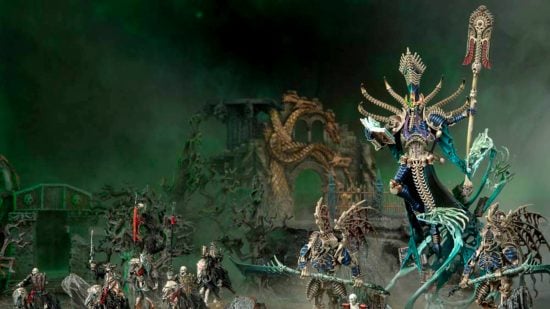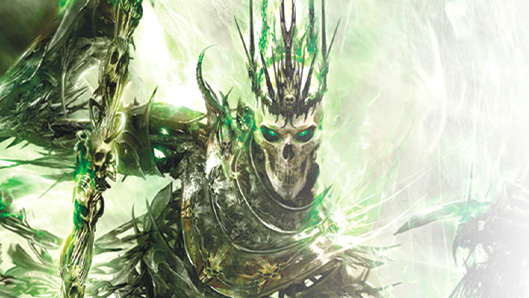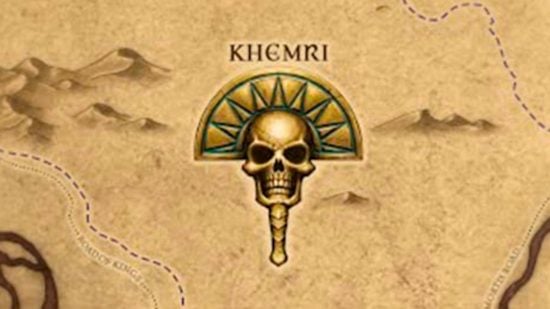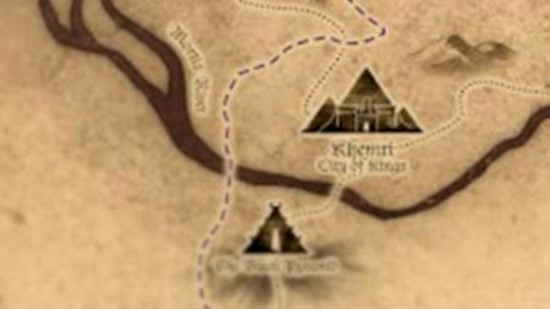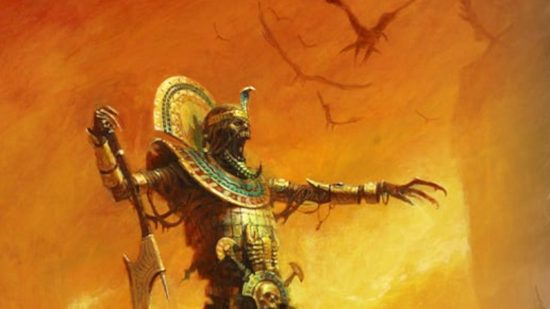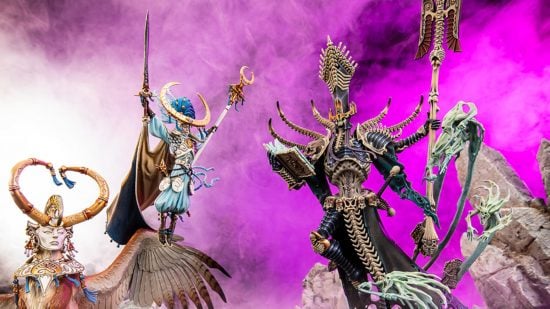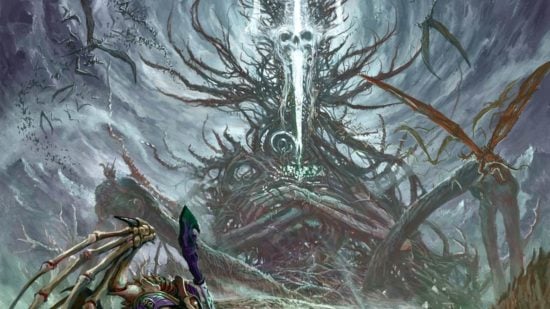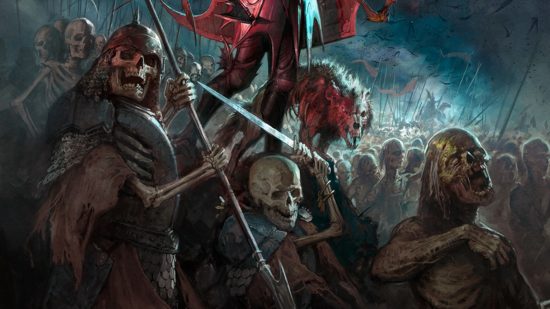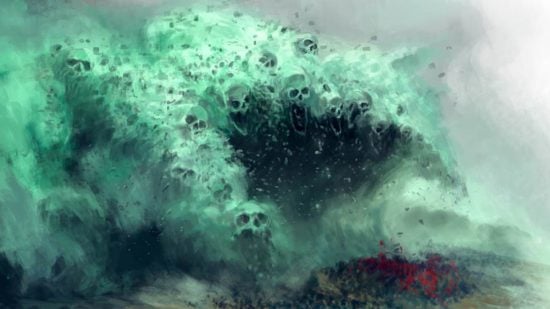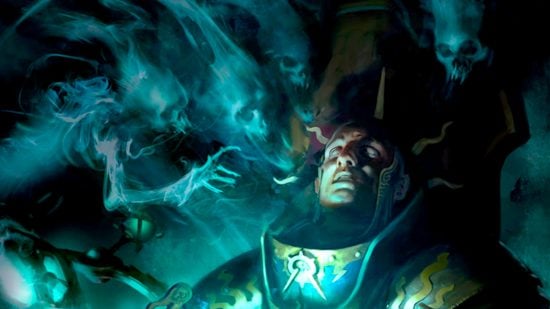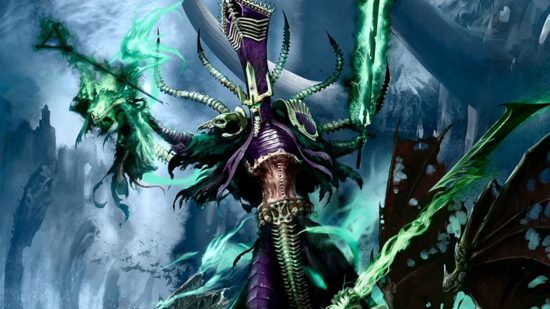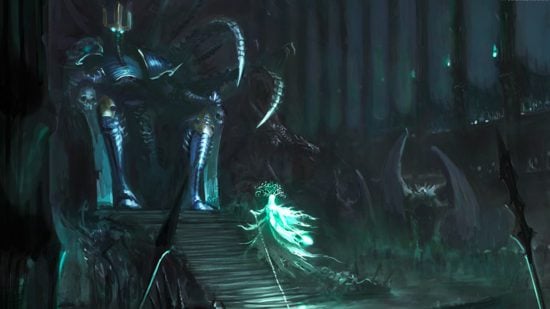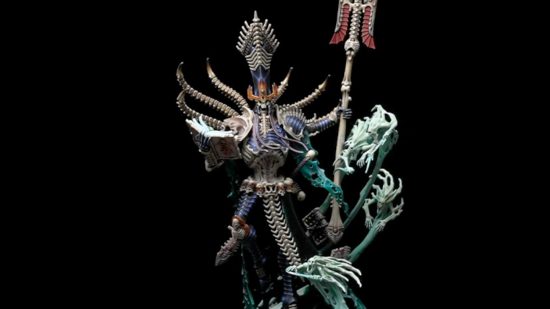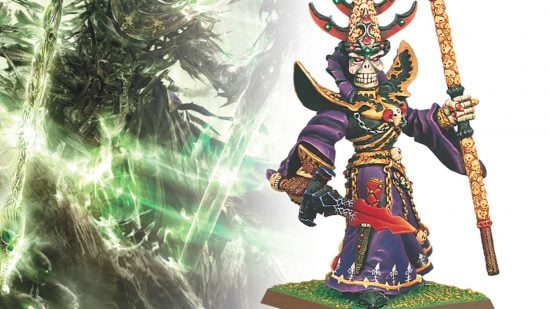Nagash is one of the oldest, bitterest, and most dangerous villains in the entire Warhammer fantasy canon. Warhammer’s first necromancer, Nagash is the ultimate puppet master of almost any skeleton, vampire, or zombie in Games Workshop games these days – so we’ve written this guide to get you up to speed on who Nagash is, what he wants, and what he’s up to – as well as that super sweet Age of Sigmar Nagash model.
For a quick primer on the current tabletop iteration of Nagash’s undead forces, read our guide to the Age of Sigmar armies – or try our complete Soulblight Gravelords and Nighthaunt guides for full details on his most recent recruits.
Warhammer’s Nagash – a guide
If you’re more interested in Nagash’s earlier Tomb Kings career, in Warhammer Fantasy Battle, best check out the latest on the Warhammer The Old World release date.
For now, though, let’s bone up on the Supreme Lord of The Undead, the Great Necromancer, Architect of the Necroquake, and all-round Pretty Unpleasant Guy.
Who is Nagash?
Nagash is one of the oldest and most impactful characters in Warhammer fantasy; an ultra-powerful mage and necromancer who created the undead in the Warhammer Old World.
He’s been killed, destroyed, or otherwise defeated several times, but always returns one way or another, by way of fell rituals and necromantic failsafes of his own – or spells cast by others to re-summon him for their own purposes.
Physically, he’s been through many different forms. He was born a mortal human; then died and returned as an undead liche; then died again at Sigmar’s hand, and was brought back again as the Incarnate of Shyish, a kind of avatar of one of the various Winds of Magic, to help fight chaos during the End Times of the Old World.
Now, in the Age of Sigmar, he’s arguably more powerful than ever. A renegade demigod of Death, he takes the form of a massive, black-armored skeleton, wreathed in coruscating waves of bones and magical force, and wielding magic power unmatched by almost any other AoS wizard.
On the Age of Sigmar tabletop, Nagash is a very powerful, very expensive-to-field Wizard character, and one of the miniature wargame‘s first (and arguably still most impressive) large scale ‘centerpiece’ minis.
But let’s begin at the beginning, shall we?
Nagash in Warhammer The Old World
Nagash is perhaps one of the top five most important characters in Warhammer: The Old World lore, and, with his erstwhile countrymen the Tomb Kings returning as one of the primary Warhammer The Old World factions, it pays to have a quick refresher on the Great Necromancer’s sparkling career in evildoing.
He was born a prince of Khemri, the ruling dynasty of Nehekhara (the Old World’s Egypt-themed desert land) but, due to tradition, his younger brother Thutep became the heir, while Nagash was forced to serve in the Mortuary Cult – the kingdom’s secretive, death-centric priestly class.
While Thutep took the throne on their father’s death, Nagash quietly excelled in the Cult, busily learning secrets of dark magic, gathering a cabal of allies, and quickly becoming a High Priest of Khemri.
Not content to remain some backstage religious figure, however, Big N plotted with his cult allies to oust his brother and become ruler of Khemri – which he eventually did by entombing Thutep alive inside their father’s pyramid, plopping himself straight on the throne, and daring anyone to argue.
After claiming power, Nagash busied himself with getting more and more necromantic power. He discovered the Elixir of Life, making himself and his closest allies immortal; he collected vast amounts of necromantic lore into the infamous nine Books of Nagash; and – most importantly – funnelled all the kingdom’s wealth into building the Black Pyramid, a gigantic focusing device to let him harness the Winds of Magic as none had ever done before.
Eventually, though, the other Priest Kings of Khemri – distrustful of Nagash and tired of him impoverishing the kingdom to build a really big black tomb – rebelled against Nagash.
During the war that followed, bitter in the face of defeat, Nagash unleashed a spell to kill and undead-ify every living thing for hundreds of miles. Though he was killed right afterwards, the spell couldn’t be un-cast, and its necromantic corruption brought various ancient Nehekharan leaders back to life, who would later be known as the Tomb Kings (the bony boys we know from the Total War Warhammer 3 factions).
After 1,111 years of slowly reincorporating in his sarcophagus in the Black Pyramid, Nagash returned to find Nehekhara ruled by a bunch of different undead kings and leaders, and went off in search of his lost crown, which he hoped would restore his strength enough to reclaim the kingdom.
Unfortunately for the necromancer, however, the crown had ended up with a little known tribal leader named Sigmar. After a failed attempt to use the crown’s magic to corrupt and enthral Sigmar, Nagash tried to take it from Sigmar’s upstart Empire by force, failed, and got killed for a second time, his head smashed in by Sigmar’s warhammer Ghal-Maraz (yes, that is the Warhammer warhammer).
After that, Nagash stayed more or less dead for many centuries, only able to act by mystically influencing others – until the End Times, when he was resurrected a second time, by his lieutenants Arkhan the Black and Mannfred von Carstein, and became the Incarnate of Shyish.
Nagash in Warhammer Age of Sigmar
In Warhammer Age of Sigmar Nagash is, to all intents and purposes, the god of death. He was set up as such in the setting’s founding Age of Myth, when he joined the God King Sigmar’s new Pantheon of Order and agreed to help structure the Mortal Realms.
On the basis of his newfound godhood, Nagash fought for ages alongside Sigmar and the other gods, new and old, to help boot chaos out of the realms. For Big N, this deal also meant the expectation that he got to be, essentially, king of the underworld – that he owned the soul of every mortal creature that died in this new world.
Slowly but surely, however, Nagash realised this simply wasn’t going to happen. The aelven gods were magically storing their people’s mortal souls to keep them from Slaanesh, and Sigmar himself was using his reforging magic to turn dying humans into immortal Stormcast Eternals – all were robbing Nagash of what he saw as his rightful property.
Nagash withdrew from Sigmar’s court, began strengthening his holdings in Shyish, the Realm of Death, and plotting his own ascendancy – aiming above all to gain total mastery over the entire realm.
When the chaos gods began their renewed assault on the Realms – ending the Age of Myth and beginning the Age of Chaos – Nagash and his forces didn’t come to the aid of the other gods, and were banished from the pantheon. Thus began Grand Alliance: Death.
Between then and now, a ton of other stuff happened in the Mortal Realms, including (shocker) lots and lots of war, the total splintering of the once-great forces of Order, and a long era of chaos dominance – but, throughout all that, Nagash was – as ever – playing the long game.
Nagash and the Necroquake
If you’ve got involved in Age of Sigmar storyline during the last few years, you’ll likely associate Nagash with the events of the Necroquake: the result of all his secret plotting, and a magical catastrophe that rocked the entire world, spawned an entire army of ghosts called the Nighthaunt, and kicked off Age of Sigmar’s second edition in 2018.
Here’s the short version: as soon as Nagash decided he was being swindled back in the late Age of Myth, he started having his undead legions collect vast quantities of grave-sand (Shyish’s precious realmstone) and turning it into shadeglass – a synthetic substance that can trap, or preserve, the souls of the dead.
Over the intervening centuries, Nagash had used the shadeglass to fashion new and greater versions of Nagashizzar (his capital city in the World-That-Was) and the great Black Pyramid itself, as part of an elaborate, monumental magic ritual that would grant him control over all Shyish. The forces of order discovered the plan, and attempted to stop it, but they were too late; the spell was already underway.
And it would have worked perfectly, too, if it hadn’t been for those meddling Skaven! A small group of perfidious ratmen made it inside the Black Pyramid during the final stages of the ritual and, while attempting to ransack the place, managed to damage its workings.
As a result, instead of simply siphoning all of Shyish’s death magic into Nagash’s hungry mouth like he’d planned, the pyramid drilled a big hole down into the realm’s core, creating a massive power vortex called the Shyish Nadir and triggering the Necroquake, an explosion and consequent tsunami of necromantic magical energy that rippled out across all the Mortal Realms.
In the necroquake’s amethyst wake, the dead of every realm began to rise from their graves; entire legions of ghostly Nighthaunt shrieked into being; and Nagash emerged stronger than ever, his power redoubled many times over by drinking in the magic released in the blast, and his undead servants flocking to his side in numbers beyond imagining.
Nagash model
Games Workshop has released precisely two Nagash models in the 40 years since Warhammer the fantasy wargame was first released in 1983.
As a pair, they encapsulate, better than almost any other example, the tectonic shift in Warhammer miniature design over the game’s history (except perhaps Angron, primarch of the World Eaters, in Warhammer 40k).
The first, a metal model designed by Gary Morely, dropped in 1994, and was exquisite at the time – but, in the years following developed a reputation as one of the ugliest Warhammer models ever made.
All the more impressive, then, when the current Nagash model, a towering, nine-inch-tall masterpiece in plastic, arrived on the scene in 2014, heralding the End Times and the launch of the brand new game Age of Sigmar.

Eight years and 3.75 editions of Age of Sigmar (and dozens of similarly big, impressive centerpiece minis) later, the Nagash model is still one of Games Workshop’s best major character minis – rather a testament to his history and impact on the lore and hobby (even if he is a bitter, grumpy, bony bastard).
And that’s all we have about Nagash, Supreme Lord of the Undead! If you’ve made it this far, the chances are you’re either already collecting a Death army for Age of Sigmar – or perhaps gearing up to play Tomb Kings in Warhammer: The Old World.
Either way, you can get a head start on your hobby with our full guides on painting miniatures, the best paints for miniatures, and even the best miniature paintbrushes to use. Looking to up your game and get dozens of skeletons painted up at once? Get yourself one of the best airbrushes, and you’re away.
Source: Wargamer



